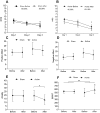Modulating Anxiety and Functional Capacity with Anodal tDCS Over the Left Dorsolateral Prefrontal Cortex in Primary Dysmenorrhea
- PMID: 32308497
- PMCID: PMC7147620
- DOI: 10.2147/IJWH.S226501
Modulating Anxiety and Functional Capacity with Anodal tDCS Over the Left Dorsolateral Prefrontal Cortex in Primary Dysmenorrhea
Abstract
Background: Primary dysmenorrhea is a common and often debilitating condition affecting 40-90% of menstruating women. This condition reduces functionality, quality of life, and social activities. Transcranial direct current stimulation (tDCS) has been used in many chronic pain syndromes, with evidence of improved pain, functionality, and mood in women with primary dysmenorrhea. The objective of this study was to determine whether tDCS could offer clinical benefits on pain, anxiety, affectivity, and functionality in women with primary dysmenorrhea.
Methods: This parallel, sham, randomized, double-blind trial was conducted with 26 women randomized into sham tDCS and active tDCS. Anodal tDCS was applied for 5 consecutive days over F3 corresponding to the left dorsolateral prefrontal cortex (DLPFC) and the cathode electrode over Fp2 for 20 min with an intensity of 2 mA. A numeric rating scale (NRS) was used to assess pain, anxiety, positive and negative affect, and submaximal aerobic performance during two consecutive menstrual cycles.
Results: No significant interaction was found between intervention and time on the NRS [F(2,44) = 1.358, p = 0.26], and a significant main effect of time [F(2,44) = 4.446, p = 0.01] was found. The active group showed a significant reduction in anxiety (p = 0.03) with a mean difference of 5.12 (95% CI 0.79 to 11.05). No significant differences in positive and negative affect were found (p = 0.95 and p = 0.15, respectively). Submaximal aerobic performance was significantly greater in the active group [F(2,21) = 5.591, p = 0.02], with a mean difference of 70.87 (95% CI 8.53 to 133.21).
Conclusion: Anodal tDCS over the DLPFC seems to be an effective therapeutic approach for improving anxiety and functionality in women with primary dysmenorrhea.
Keywords: anxiety; functional capacity; menstrual cycle; non-invasive brain stimulation; pain.
© 2020 Dutra et al.
Conflict of interest statement
The authors report no conflicts of interest in this work.
Figures



Similar articles
-
Effects of Transcranial Direct Current Stimulation for Treatment of Primary Dysmenorrhea: Preliminary Results of a Randomized Sham-Controlled Trial.Pain Med. 2020 Dec 25;21(12):3615-3623. doi: 10.1093/pm/pnz202. Pain Med. 2020. PMID: 31498389 Clinical Trial.
-
Anodal HD-tDCS on the dominant anterior temporal lobe and dorsolateral prefrontal cortex: clinical results in patients with mild cognitive impairment.Alzheimers Res Ther. 2024 Feb 3;16(1):27. doi: 10.1186/s13195-023-01370-y. Alzheimers Res Ther. 2024. PMID: 38310304 Free PMC article. Clinical Trial.
-
Transcranial direct current stimulation for the treatment of generalized anxiety disorder: A randomized clinical trial.J Affect Disord. 2019 Dec 1;259:31-37. doi: 10.1016/j.jad.2019.08.020. Epub 2019 Aug 15. J Affect Disord. 2019. PMID: 31437698 Clinical Trial.
-
Effect of transcranial direct current stimulation in addition to visuomotor training on choice reaction time and cognition function in amateur soccer players (FAST trial): A randomized control trial.Neurosci Lett. 2022 Jan 1;766:136346. doi: 10.1016/j.neulet.2021.136346. Epub 2021 Nov 14. Neurosci Lett. 2022. PMID: 34785310 Clinical Trial.
-
Evidence-based guidelines on the therapeutic use of transcranial direct current stimulation (tDCS).Clin Neurophysiol. 2017 Jan;128(1):56-92. doi: 10.1016/j.clinph.2016.10.087. Epub 2016 Oct 29. Clin Neurophysiol. 2017. PMID: 27866120 Review.
Cited by
-
Is transcranial direct current stimulation beneficial for treating pain, depression, and anxiety symptoms in patients with chronic pain? A systematic review and meta-analysis.Front Mol Neurosci. 2022 Dec 1;15:1056966. doi: 10.3389/fnmol.2022.1056966. eCollection 2022. Front Mol Neurosci. 2022. PMID: 36533133 Free PMC article.
-
Letter to the Editor Regarding 'Neuromodulation for Management of Chronic Pelvic Pain: A Comprehensive Review'.Pain Ther. 2023 Aug;12(4):1095-1097. doi: 10.1007/s40122-023-00517-x. Epub 2023 May 6. Pain Ther. 2023. PMID: 37148446 Free PMC article. No abstract available.
-
Application of tDCS in children with cerebral palsy: A mini review.Front Pediatr. 2022 Sep 20;10:966650. doi: 10.3389/fped.2022.966650. eCollection 2022. Front Pediatr. 2022. PMID: 36204667 Free PMC article. Review.
-
Regulation of Mild Moxibustion on Uterine Vascular and Prostaglandin Contents in Primary Dysmenorrhea Rat Model.Evid Based Complement Alternat Med. 2021 Jul 10;2021:9949642. doi: 10.1155/2021/9949642. eCollection 2021. Evid Based Complement Alternat Med. 2021. PMID: 34335847 Free PMC article.
-
Clinical usability study of a home-based self-administration transcranial direct current stimulation for primary dysmenorrhea: A randomized controlled trial.PLoS One. 2024 May 2;19(5):e0301851. doi: 10.1371/journal.pone.0301851. eCollection 2024. PLoS One. 2024. PMID: 38696453 Free PMC article. Clinical Trial.
References
-
- Osayande AS, Mehulic S. Diagnosis and initial management of dysmenorrhea. Am Fam Physician. 2014;89(5):341–346. - PubMed
Publication types
LinkOut - more resources
Full Text Sources
Medical
Miscellaneous

